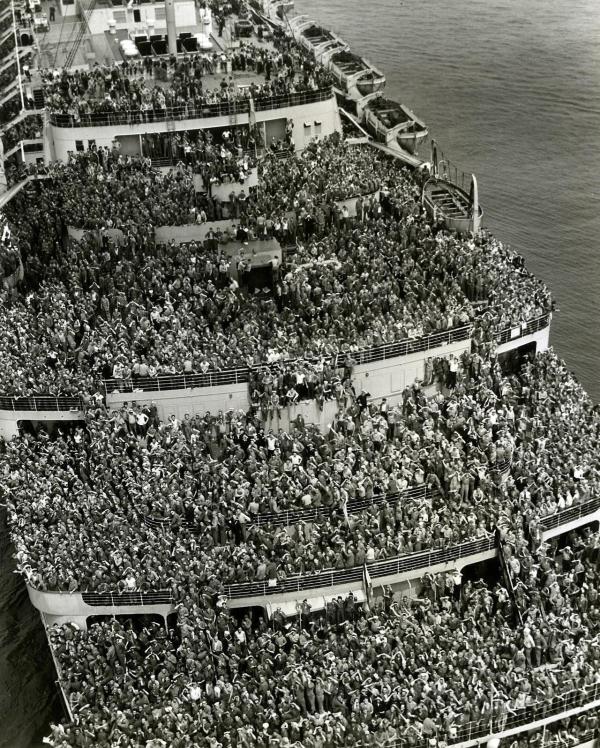Schedule Your Complimentary Strategy Session Today
What happened with high inflation after WWII in 1946 when our soldiers returned home?
We keep hearing about how this inflation cycle is going to be like the 1970s, but what if it is more like 1946? Remember that one? Me neither. As Ron K said on CNBC, “we don’t repeat the mistakes of our parents, we repeat the mistakes of our grandparents”. Why? Our collective memory is short.

What happened in 1946? WWII had ended. Soldiers came back home, got married, bought houses and tons of other things: cars, appliances, etc. The economy reopened in a mangled fashion:
- Pent up demand existed because returning soldiers hadn’t been able to buy much while they were off fighting the war. Likewise with the civilians at home where goods were rationed during the war. Their personal savings accounts soared, and they were ready to spend.
- Supply shortages existed because factories had been utilized for the war effort for so many years. They weren’t producing washing machines and cars, but weapons and tanks. It took time to repurpose those factories.
- Price controls were eliminated after WWII which also sent prices climbing.
What happens when there is pent up demand paired with supply shortages? Inflation.
Inflation in 1945 was 2.3%.
One year later, in December 1946, it soared to 18%.
It peaked in March 1947 at 20%.
By December 1947, it decreased to 9%.
By December 1948, it was down to 3%.
And by December 1949, it was -2.1%.
How did inflation fall that quickly in the 40s?
According to Benjamin Caplan (1956), it ended after two years as domestic and foreign supply chains normalized and consumer demand began to level off.
What did the Fed do? It increased interest rates moderately from 1.875% in 1945 to 2% in 1946 and 2.125% in 1947. That’s it.
Perhaps this cycle is more like 1946-47 than it is like the 1970s.
And perhaps that’s why the Fed isn’t raising rates to where they were in the 80s, around 14-15%.
Other similarities between today and 1946-47.
We just had a war with Covid, factories shut down and the supply chain went awry. There was an expansion of the money supply - During Covid we spent as much as we did in WWII - People received their stimmies. People’s savings grew and now they are ready to spend.
So, inflation could come down a lot faster and might not be as entrenched as many think.
Notable people who agree: CEO of Stifel Ron Kruszewski, CIO of Guggenheim Partners Scott Minerd, and The Council of Economic Advisors (to the White House) who put it, “No single historical episode is a perfect template for current events. But when looking for historical parallels, it is useful to concentrate on inflationary episodes that contained supply chain disruptions and a spike in consumer demand after a period of temporary suppression. The inflationary period after World War II is likely a better comparison for the current economic situation than the 1970s and suggests that inflation could quickly decline once supply chains are fully online and pent-up demand levels off.”
Schedule Your Complimentary Strategy Session Today
Post Script
It’s important to remember that the yearly inflation rate by month stated above is separate than the annual average inflation rate. The prior is year over year inflation vs. calendar year annual inflation below.
Average Annual Inflation
|
1945 |
2.3% |
|
1946 |
8.3% |
|
1947 |
14.4% |
|
1948 |
8.1% |
|
1949 |
-1.2% |
https://www.ft.com/content/f6bf6064-a348-4f37-b784-5b9e7ba05448
https://www.youtube.com/watch?v=LmzseTwu4lw
https://www.officialdata.org/1950-dollars-in-1945?amount=0.50
https://cpiinflationcalculator.com/1945-cpi-inflation-united-states/
https://cpiinflationcalculator.com/1946-cpi-inflation-united-states/
https://cpiinflationcalculator.com/1947-cpi-inflation-united-states/
https://cpiinflationcalculator.com/1948-cpi-inflation-united-states/
https://cpiinflationcalculator.com/1949-cpi-inflation-united-states/
https://rarehistoricalphotos.com/crowded-ship-bringing-american-troops-1945/
https://www.nationalww2museum.org/war/articles/points-system-us-armys-demobilization